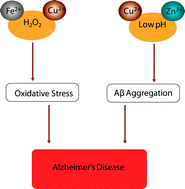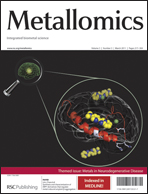Role of metal dyshomeostasis in Alzheimer's disease†
Abstract
Despite serving a crucial purpose in neurobiological function, transition metals play a sinister part in the aging brain, where the abnormal accumulation and distribution of reactive iron, copper, and zinc elicit oxidative stress and macromolecular damage that impedes cellular function. Alzheimer's disease (AD), an age-related neurodegenerative condition, presents marked accumulations of oxidative stress-induced damage, and increasing evidence points to aberrant transition metal homeostasis as a critical factor in its pathogenesis. Amyloid-β oligomerization and fibrillation, considered by many to be the precipitating factor underlying AD onset and development, is also induced by abnormal transition metal activity. We here elaborate on the roles of iron, copper, and zinc in AD and describe the therapeutic implications they present.

- This article is part of the themed collection: Metals in Neurodegenerative Disease

 Please wait while we load your content...
Please wait while we load your content...